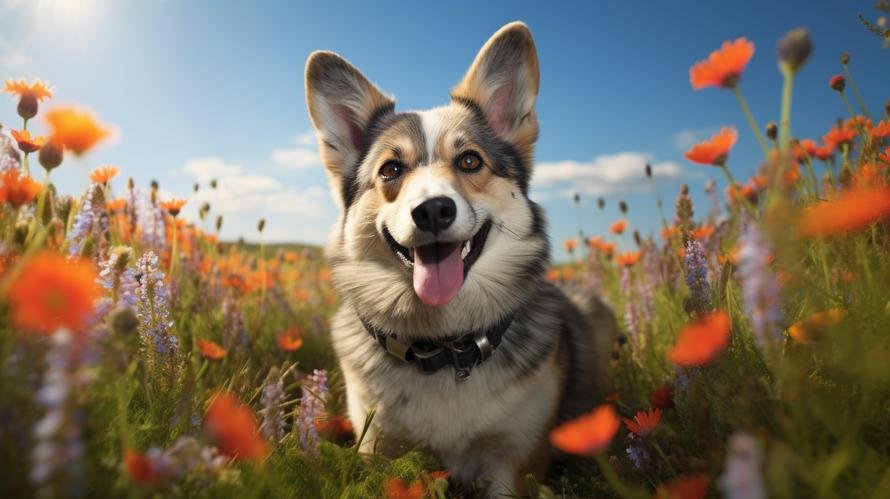Picture a Viking ship from ancient times, a swift vessel gliding through icy waters. Onboard, among the fearsome warriors and explorers, you might be surprised to find a small, sturdy dog with pointy ears and a curly tail, eagerly watching the shoreline pass by. This isn’t just any dog, but the ancestor of the Swedish Vallhund, also known as the “Viking Dog.” With their deep historical roots and a strong connection to the past, these dogs are a living link to a bygone era.
The Swedish Vallhund, despite its warrior-like heritage, is often thought of as a calm and collected breed, displaying a serene demeanor that might remind you more of a monk in meditation rather than a dog bred for herding and guarding. Their temperament is one of balance and thoughtfulness, characteristics that have endeared them to dog lovers around the globe.
These little powerhouses, standing about 12 to 16 inches at the shoulder, have been helping herd cattle and sheep as far back as the 8th century. So it’s no wonder they’ve earned a reputation for being alert, intelligent, and yes, quite even-tempered. But the question remains: Are they as calm as they seem, or is there more to this pint-sized Viking companion than meets the eye?
When assessing the calmness of a Swedish Vallhund, it’s essential to consider their energy levels. They were bred to work, which means they have lots of energy to burn. However, with the right amount of exercise, mental stimulation, and consistent training, these dogs can exhibit a level of calmness that makes them excellent companions for families, singles, and the elderly alike.
A typical day in the life of a Swedish Vallhund does not involve lying around – they’re too busy for that! This breed thrives on having jobs to do, whether those jobs involve herding livestock, completing agility courses, or playing interactive games with their humans. Give them a purpose, and they’ll show you the full extent of their focus and tranquility.
To achieve this sought-after calmness, it’s crucial to start with proper training and socialization from a young age. The intelligence and eagerness to please found in Swedish Vallhunds make them a joy to train. These traits allow them to learn commands quickly and respond well to positive reinforcement techniques such as praises, treats, and playtime.
Additionally, establishing a routine can work wonders for maintaining their serenity. Vallhunds respond well to knowing what to expect in their day-to-day lives. Having set times for walks, meals, and quiet times can help them feel secure and content, reducing any anxious or hyperactive behavior that could arise from uncertainty or boredom.
While training and routine are vital, so is the importance of exercise. A brisk walk or an energetic play session each day can help in managing their energy levels. Vallhunds are especially fond of games that stimulate their herding instincts, such as fetch or herding balls, which mimic the motion of livestock. These activities not only tire them out physically but also provide the mental workout they crave.
In addition to physical activity, mental exercise is just as important. Swedish Vallhunds are smart cookies, which means they can get bored easily if not mentally challenged. Puzzle toys, scent work, and even learning new tricks can keep their minds occupied and prevent the restlessness that may lead to less than calm behavior.
Another factor in the Swedish Vallhund’s demeanor is their health. Like all breeds, Vallhunds can suffer from certain health issues that might affect their behavior. Keeping up with regular vet visits, maintaining a healthy diet, and watching their weight will contribute to their overall well-being and temperament.
Now, let’s talk about their interactions with children and other pets. Swedish Vallhunds can be calm and gentle companions for kids when appropriately socialized. Their tolerant nature and sturdy build make them capable playmates, able to handle the exuberance of children while not being so fragile that play needs to be overly cautious. As with any breed, interactions should always be supervised to ensure safe and enjoyable playtime.
When it comes to other pets, these Viking descendants are typically sociable and can coexist peacefully with cats and other dogs, especially when raised together. Their innate herding instincts might kick in from time to time, so it’s essential to monitor their interactions and discourage any behavior that might be too controlling or intense for their furry housemates.
Living Conditions play a role in the temperament of a Swedish Vallhund. While they can adapt to various living situations, including apartments, they do best with a bit of space to move around. A home with a securely fenced yard is ideal, offering them a safe place to explore, play, and, yes, even engage in a little herding behavior without any sheep in sight.
In the end, Swedish Vallhunds have the potential to be calm and well-mannered dogs if their physical, mental, and emotional needs are met. They may not have the zen-like tranquility of a dog lounging by the fireplace all day, but they possess a balanced energy that, when channelled correctly, leads to a harmonious life with their human companions.
If you’re considering bringing a Swedish Vallhund into your life, remember that a calm dog is a happy dog, and a happy dog is a product of a caring and attentive owner. Dedicate time to training, exercise, mental stimulation, and affection, and you’ll have a loyal friend whose calm demeanor is matched only by their enduring spirit.
While our seafaring days may be long gone, the heart of a Viking lives on in these amiable canines. Embodying both the vigor of ancient warriors and the calm of seasoned sailors, the Swedish Vallhund is a testament to the power of nurturing and companionship in shaping the character of even the most spirited breeds.



